"Weaving", which became the "Foot"
V.M., Head of the Design Department and First Deputy Director of the Plant for Experimental Designs of the Central Aerohydrodynamic Institute (ZOK TsAGI) Petlyakov could not complain about the fate until the second half of the year 1937. He was one of the closest associates of A.N. Tupolev. Having developed the wing of the famous TB-3 and who led the development of the newest long-range high-altitude bomber TB-7, Petlyakov enjoyed friendly support from the leadership of TsAGI and the People's Commissariat. In the middle of 1937, he participated in the work of the Soviet delegation in the United States and France, which ended with the purchase of licenses for several foreign aircraft, including the famous DS-3. However, by the winter of 1937, the situation changed dramatically.
At the end of the year, the AN design bureau, the largest in our country, actually ceased to exist. Tupolev. Shortly before, from his design bureau to other, separate, part of the designers were engaged at that time, refining and improving such combat vehicles as SB (design bureau AA Arkhangelsky) and ANT-51 or BB-1 (design bureau P.O. Dry). Soon many of the remaining design bureau, including A.N. Tupolev, arrested along with his closest assistants - V.M. Petlyakov and V.M. Myasishchev suffered from "Yezhovshchina" workers and other design and research organizations. After some time, although many of the arrested designers and scientists were not released, they nevertheless organized special design bureaus from the NKVD.
In the autumn of 1938, the NKVD system formed CCT-29 under one roof, or, as it was also called, OTB (Special Technical Bureau). Its organizational structure includes three design bureaus: KB-100 under the direction of V.M. Petlyakov, KB-102, headed by V.M. Myasishchev, and KB-103, led by A.N. Tupolev. Somewhat later, KB-110, headed by DL, was added to them. Tomashevich. Formally, the leadership of all carried out by the NKVD.
All of these design teams were developing new models of combat aircraft, which subsequently received the designation of designation numbers. The first to receive the assignment was the creation of a new aircraft and, basically, completed personnel replenishment - KB-100. Its core, along with V.M. Petlyakov was made up of people who had already worked in aviation many years and had extensive experience: A M. Isakson (deputy Petlyakova), V.M. Myasishchev (first the head of the wing brigade at Petlyakov, then headed KB-102), E.P. Shekunov, K.G. Nurov, I.K. Protsenko, S.M. Leshchenko, P.L. Otgen, Yu.T. Shatalov, N.I. Pogossky (later returning to Tupolev), K.V. Rogov, S.M. Meyerson, N.I. Polonsky.
They laid the main responsibility for the implementation of a new, one of the priority tasks - the development of a high-altitude fighter-interceptor. This aircraft was supposed to destroy enemy air vehicles for any purpose at altitudes 10-12 km. Quite a lot of others, in particular, A.I. Mikoyan and M.I. Gurevich (fighter I-200, the design of which began even NN Polikarpov), P.O. Sukhoi (I-330 or Su-1) and A.S. Yakovlev (I-28). Yes, and prototypes of the later known Yak-1 and LaGG-3, called the I-26 and I-301, respectively, according to the initial plans were worked out in high-altitude versions.
The interest of the military to such machines was determined by the experience of the air battles in the sky of Spain and China. The leadership of the Air Force, after examining the fighting and making calculations taking into account the prospects for the development of aircraft, concluded that a possible increase in the speeds and heights of the action of bombers seeking to attack rear facilities would make it extremely difficult to intercept them. Soviet fighters did not have time to intercept enemy aircraft, even if they had timely information from the air surveillance service.
On this occasion, the brigade commander P.P. Ionov, in his well-known book Fighter Aviation, wrote: “The greater the flight altitude of enemy aircraft, the further from the front line it can be intercepted by fighters. We know that the heights of possible flights of bomber aircraft are increasing from year to year. We also know that the increase in the speed of transmission of information about the flight of enemy aircraft and the speed of departure of our fighters is lagging as compared to the increase in the speed of flight of bombers, and as a result, the width of the tactical suddenness band. The flight heights of modern combat aircraft reach 9000-11000 m for single-engine and twin-engine machines and up to 8000 m for multi-engine ones. The combat height of military aircraft can soon be increased and will reach the stratosphere (more than 11000 m). It should also be noted that the higher the flight of enemy bombers, the greater their distance from the front is their interception by the fighters of defense with the ever deeper airfield basing of the fighters themselves. ”
Creating a high-altitude fighter aircraft was an extremely difficult technical challenge in 1939. One of the main problems in it was the problem of ensuring the required power of the power plant at high design heights. The most effective (though not the only) tool was a turbocharger (TC), driven by the energy of the exhaust gases of the engine itself.
In 1939, the first operational TCs were already created in our country, so the designers of high-altitude aircraft had a certain arsenal of tools at their disposal. The prototype Petlyakov “100” aircraft, designed in the 1939 year, became the first domestic high-altitude combat vehicle. At that time, when it was developed, it was believed that a high-altitude fighter, which is designed to intercept and destroy the enemy's bomber, and, first of all, at a great distance from the objects of their attack, it is advisable to do multi-seat. After all, the pilot of a single-seater during an air battle with bombers at high altitudes is difficult to simultaneously control the machine, fire, monitor the air situation and maintain radio communication. It was also required not only high speed, but also an increased radius of action. Tactical and technical requirements provided for 100 at an altitude of 10000 meters to have a maximum speed of 630 km / h, a practical ceiling of 12500 m and a range of flight of 1400 km with normal take-off weight, and up to 2500 km in the overload variant.
Tactical and technical requirements for range and combat load set the number of engines, weight and size of the machine (wing area 41 sq. M, take-off weight 7200 kg, reloading 8000 kg). The required height was achieved by the presence of a pair of turbochargers TK-2 installed on each engine M-105.
The designers paid close attention to achieving a high aerodynamic and weight perfection of the machine. The wing of the fighter was recruited from the speed profiles of TsAGI type “B” (at the root) and “B”. These profiles at small angles of attack had a large critical number M compared with others. Already in those years one had to reckon with this, especially when developing high-altitude machines, since the speed of sound, say, by 11 km, is 13% less than that of the ground.
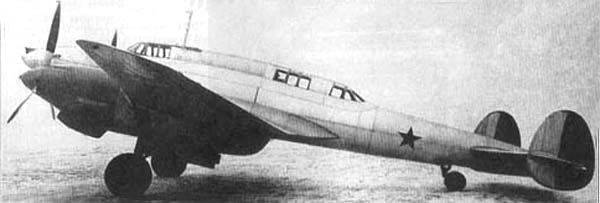
For 100, such profile properties were important not so much for horizontal flight, as for diving at maximum altitudes, when the aircraft could reach significant speeds. In addition, these profiles had a small aerodynamic moment, which gave a significant reduction in torque on the planes of the wing. The weight of the structure decreased, high speeds were achieved - horizontal and diving with excellent stability on these flight modes.
But the selected profiles had a significant drawback - small bearing capacity. This worsened the maneuverability and also the landing characteristics of the aircraft. True, for 100, these qualities were not considered paramount.
Much attention has been paid to other elements of the 100 layout. Water radiators to reduce resistance "drowned" in the wing, and the oil radiators were placed in streamlined tunnels under the engine nacelles. No structural elements disturbed the smoothness of the forms. In short, the layout designers implemented at a very high level of aerodynamics. Later this was especially noted by military experts.
Petlyakovskaya "weaving" was the first domestic combat aircraft, equipped with pressurized cabins, which were part of the power structure of the fuselage. At altitudes up to 10 km, they maintained a pressure equal to that of 3,7 km. This significantly increased the performance of the crew when performing long flights at high altitudes.
The cabs had a fairly good view. In the front there was a pilot, in the rear - a navigator-scorer with a gunner-radio operator. In the nose of the aircraft was a gun-gun battery. It consisted of a pair of ShKAS machine guns and two ShVAK rapid-fire cannons.
The fighter provided for a remote-controlled installation with a ShKAS machine gun to protect the rear hemisphere. In the area of the center-section in the fuselage, a bomb bay was arranged to accommodate two cassettes capable of holding 48 artillery shells of mm 76 caliber or up to 96 aerial bombs of 2,5 caliber kg. This armament was supposed to be used on enemy aircraft (including diving), for example, on the structure of bombers for their defeat and disruption of battle formation. This combat technique was considered in those times a promising means of dealing with enemy aircraft. In Italy, even conducted tests on the use of fighter artillery shells, grenades, fragmentation bombs on the structure of "bombers".
Many innovations have been used by designers in the control systems of various systems and aggregates of the “weave”. For the first time in the Soviet practice of aircraft building, electromechanisms were widely used to drive units. The main thing here was that the electrical wiring to the mechanisms instead of a large number of rods allowed to ensure the tightness of the cabs with the help of special leads. The control of radiator dampers, discharge speeds, switching of TBCs, shields and trimmers was carried out by electromechanisms.
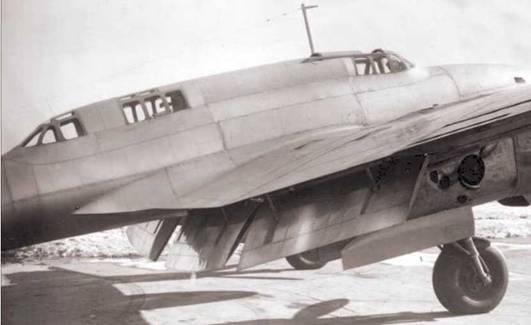
The design of the all-metal twin-engine fighter "100" was a great step forward. At the stage of the mockup commission, military representatives noted that a thorough study of the fundamental tasks of the tactical and technical requirements for it had been carried out. But over time, their attitude towards the destination of the aircraft began to change gradually. Now the customer has shown more and more interest in the possibility of using the "weave" as a diving bomber. The machine, with an 9200 take-off weight, could carry up to a ton of bombs on an external sling and destroy ground targets with a high accuracy with a dive. Initially, the new assignment was considered by the military as an additional, and then as equal with the previously conceived.
As a result, the appointment of a twin-engine aircraft "100", despite the objections of the designers, was determined both as a high-altitude fighter and a diving bomber. In short, the "weaving" became multipurpose. What caused this? Of course, at that time final ideas about the character of the approaching war and the role of high-altitude fighters and dive-bombers in it were not yet formed. After all, Germany - a potential adversary - did not possess large compounds of such machines. They were not in the seizure of Poland, France, during the "Battle of England" in 1940.
In addition, the Soviet delegation got acquainted with military aircraft and German industry in 1939. She noted that the development of high-altitude engines with TK is the Germans only in the experimental stages. Consequently, there was no special need for a special high-altitude fighter. That is why such machines as the I-26 and I-301 were not created either. But there was an acute need for a new type of combat vehicle - a high-speed dive bomber. The same experience of the war argued that dive bomb attacks greatly simplify the defeat of small targets.
The design of the aircraft "100" went at a rapid pace. In May 1939, its layout was approved by a commission of military specialists headed by A.I. Filin, and at the end of 1939, the first prototype was taken to the airfield.
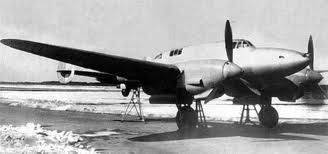
Flight tests "weave" in the role of a fighter began 22 December 1939 year. Factory tests completed 10 on April 1940. The 23 flight was performed on them. There were troubles. Once, landing skis were not released, and the plane had to be put on the belly, then repaired.
During the tests, the aircraft was refined and refined. In particular, to improve stability, the area of each keel (without elevators) was increased from 0,77 square. m to 1,0 square. m, after refining the surface, the speed increased by 14 km / h.
Immediately after the factory tests, the state began (from April 11 to May 10 of the year 1940). Unfortunately, due to the unreliable operation of the engines at altitudes above 5 km, it was not possible to remove full flight characteristics in flights up to the ceiling (at altitudes of the order of 7-8 km single flights were performed), the engines in them did not work at maximum mode. Turbochargers proved to be quite reliable at all heights and did not cause any complaints.
As for hermetic cabs, testers noted: even without complete sealing, they maintain the temperature inside about + 8 ° С at an altitude of 8 km, where the ambient air temperature is -37 ° С, protects well from the noise of motors and screws, and this facilitates long-term stay at high altitudes.
With complete sealing in the cabins it was even hot (the temperature reached + 30 ° С) and some of the glazing of the lamp was misting. Curious impression test pilot PM. Stefanovsky, recorded in the report on state tests: "Due to the presence of sealants, the flight mode is not felt and with reduced attention it is possible to lose speed." Further in the conclusions it was noted that this reason, along with others, "complicates the piloting of the aircraft and makes it available to the pilot above the average qualification".
Now, when the thermocabines have become firmly established in aviation and have long been put even on training jet planes, such a cautious approach to their use may seem like a reinsurance. But it should be remembered that in those years, mostly, the crews flew in open cockpits.
Although the aircraft "100" showed the speed (where it was possible to determine) on 10-12 km / h below the calculated one, it completely satisfied the military with this quality. In general, despite the need to carry out a large number of improvements (mainly in terms of improving cooling systems, chassis damping, some piloting and performance characteristics), the Institute gave high marks to the car. For example, in the decision of the Technical Council of the Main Aviation Supply Administration (GUAS), chaired by A.I. Owl 25 May 1940.
In the spring of 1940, the 100, an understudy of the 1000 aircraft, which was slightly different from the first car, came to the test. It provided, in addition to the external suspension 600 kg of bombs, also the internal - on XNUMX kg.
In the second flight on the backup - an accident due to a fire on board. Tests did not take place.
By the decision of the said technical council, the design bureau Petlyakov proposed to alter the "weave" into a variant of the mass diving bomber with a maximum speed of 540 km / h at 5000 meters most demanded for the Air Force. On the option of mixed use is no longer talked, although at first it was planned to make a military series in 1940 copies. In June, the 15 of the Year issued a decree of the Defense Committee on the introduction of the aircraft into the series at two plants No. XXUMX and No. XXUMX (Moscow) in a variant of a diving bomber and an escort fighter. Thus, the fighter qualities of "1940" still tried to use.
So ended story 100 high-altitude aircraft. It cannot be said that the decision on its alteration in a modification of a diving bomber was greeted with enthusiasm in the Petlyakov Design Bureau. After all, the fact of launching the car into the series (if it had taken place) meant for many designers the end of their conclusion, which could now last. They could not fail to see that in such a short time allotted for the alteration of the machine, it would be very difficult to eliminate a number of aircraft deficiencies that were not so important for the fighter, but would noticeably worsen the combat and piloting qualities of the bomber. So it turned out later.
In December, the 1940 of the year came to the test a bomber version of the machine. It was he who received the name Pe-2. At the beginning of 1941, state tests passed the head serial. Mass production was also established in two factories.
Pe-2 had a number of differences from the prototype «100», dictated by other purposes. There were no hermocabines on it, the navigator was placed in the same cabin with the pilot. This provided a good overview (the requirement for the navigator of the bombers of those years is one of the most important). Strengthened defensive weapons. Under the wing mounted brake grilles. Turbochargers removed.
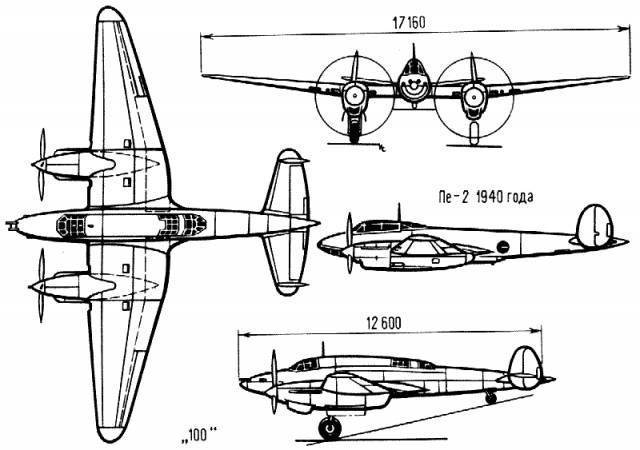
The serial production of Pe-2 bomber was rapidly gaining momentum, but by the beginning of the war, these aircraft had released a little. In the first half of the year 1941 - 458 machines. In their combat parts received much less. However, the Pe-2 marked a qualitatively new stage in the development of the Soviet bomber aircraft. He replaced the Security Council, which surprised at one time with great speed. I must say that the Security Council of the last modification was adapted for dive bombing. The main difference between these aircraft was that the Pe-2 created at a higher level of aerodynamics had a much higher speed. This fully reflected the general trend in the development of combat aviation on the eve of the Second World War. Pe-2 (without external bomb suspension) was not much different in speed from the main German fighter Me-109E at that time and significantly surpassed the main German dive bomber Ju-88-1, as well as D-215 and many front-line bombers from other countries.
This property allowed to use it, if necessary, as a fighter to fight bomber and reconnaissance aircraft. In addition, in the 1941, a double fighter version was created, which was designated Pe-3, and was also mass-produced.
However, in cases where the Pe-2 was used for dive-bombing or for massive bomb strikes, an external bomb suspension was used. This greatly reduced the speed of the bomber. To perform these combat missions, Pe-2 formations needed fighter cover.
Comparing the Pe-2 with the most common German dive bomber Ju-88-1, we can conclude that the former had a significantly higher speed, even with an external bomb suspension. On defensive armament, the Pe-2 of the first series and Ju-88А turned out to be close, but they strengthened the pawn with the 13 rifle armament: instead of the fixed ShKAS, a Berezin heavy machine gun (12,7 mm) was installed in the nose. The same machine gun instead ShKAS armed shooter. However, in terms of parameters such as the maximum bomb load and flight range, the Pe-2 was inferior to the Ju-88-1.
The difficult situation in the domestic aircraft in the pre-war period required the full speed up of work on new machines. Under these conditions, it was sometimes necessary to put up with one or other shortcomings of the new technology, if only it were more likely to adjust its mass production. So it was with Pe-2 because of the extremely limited time allotted for its creation and development in the series. The largest flaws were the selection of wing profiles that was unsuccessful for a bomber due to its low bearing properties. This greatly complicated the piloting and landing. To alter the wing under a different profile, more suitable for a bomber, there was no time. This negative quality automatically led to a takeoff weight limitation (8500-8700 kg instead of the planned 9200 kg).
The second major drawback of the aircraft was too much roll reaction when a slip occurred. It was not always possible to fend off the emerging aileron roll. It happened that with a sharp deceleration of one of the motors or its sudden failure, the car reacted so violently with a roll that sometimes it even turned out to be on its back before the pilot managed to take emergency measures. Such properties, especially dangerous on takeoff, sometimes led to disasters. During the operation of the Pe-2 drill pilots had to teach special piloting techniques.
The experience of the war proved that, despite all the flaws, the Pe-2 was very highly effective weapons. In addition, until its middle, it was our only serial type of the new front-line dive bomber.
Dive bombing as one of the most effective methods of destroying small targets was used then by many belligerent countries. In the USSR, for example, in 1943, this type of bombing was 39%, in 1945, 49%. Here the Pe-2 was very good. High dive stability in combination with high flight speed, excellent maneuverability for the bomber, visibility from the cockpit and navigator allowed the crews to deliver unexpected sniper strikes. The history of war knows many such examples. Hero of the Soviet Union N.D. Kolesnikov talked about his front-line friend: “He was meant for“ fine ”work and did a great job with it ...”
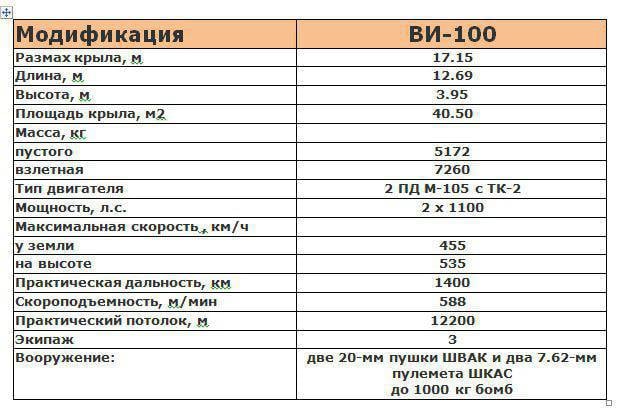
Sources:
Kotelnikov V. Heavy Petlyakov fighters - "100" / Pe-3 / Pe-3 bis // Aviation and Cosmonautics. 1998. No.05-06. C. 1-8.
Kotelnikov V. Evolution of Pe-2 // AC. 1990. No.1. C.12-17.
Kosminkov K. From “weave” to “pawn” // Wings of the Motherland. 1994. No.3. C. 2-5.
Ivanov S. Pe-2 // War in the air. No.113. C.2-6.
Shavrov V. The history of aircraft designs in the USSR 1938-1950. M .: Mashinostroenie, 1988. C. 163-165.
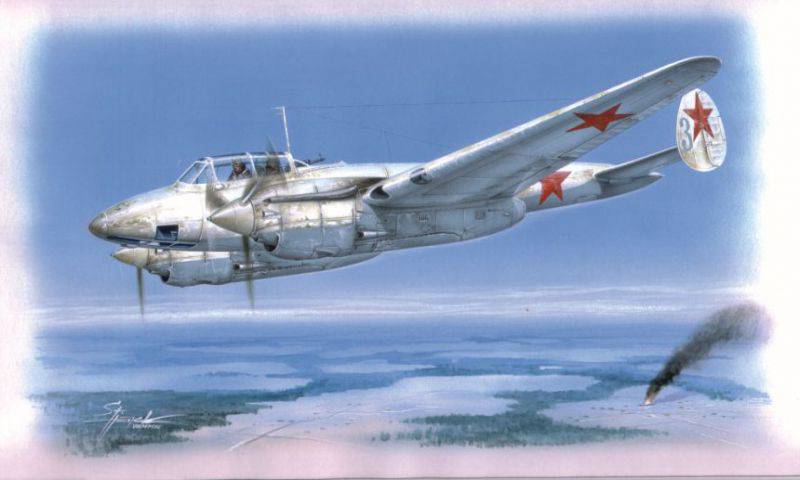

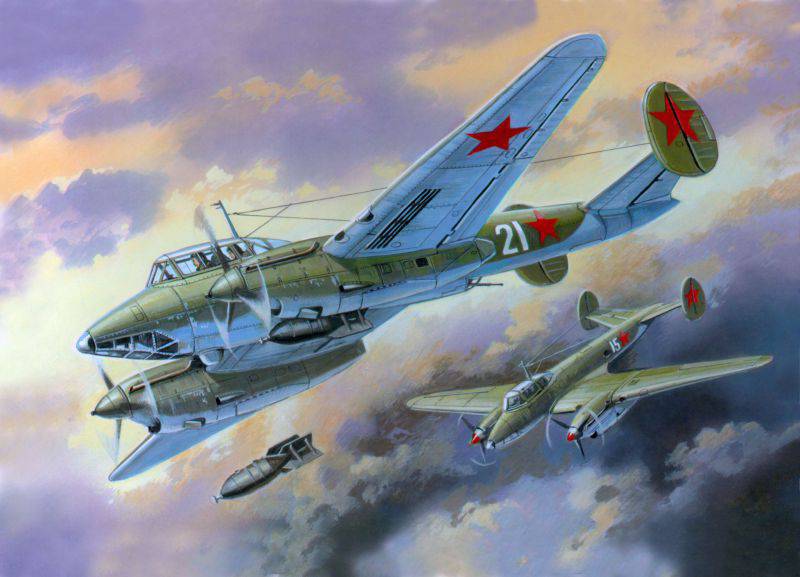
Information